official aid
Institutional improvement
KOICA has been continuously building and developing various policies for effective project implementation over the past 20 years. This section presents the meanings of these policies and the changes made during their evolution.
1. Establishment of Country Partnership Strategy (CPS)
Country Partnership Strategy (CPS) is one of KOICA’s major ODA management tools. It was selected in order to increase the effectiveness of development cooperation and it includes ways to plan mid and long term assistance and manage the results. With the gradual adoption of CPS by the World Bank in the 1990s, CPS gained popularity with major development cooperation agencies and most agencies are now strategically applying similar tools under different names.
KOICA created aid strategies for 19 partner countries in 2008 after establishing three-year mid and long-term CPSs from 2005. Initially, CPS was applied to loans and grants separately, but in December 2010, the Committee for International Development Cooperation decided to establish consolidated CPS for loans and grants. In accordance with the Korean government’s ODA policy of adopting CPS, KOICA reorganized its aid projects by region in February 2011. KOICA is now contributing to progress of national development plans made by the partner countries themselves. KOICA has been selecting priority programs and mapping specific implementation methods through CPS to achieve country and sector specific development goals. KOICA plans to apply a program- based approach (PBA) in international development cooperation by utilizing and applying diverse modalities of international development cooperation in an integrated fashion, and organically manage the processes by standardizing the CPS procedures of project discovery and development per program unit, screening, and monitoring and evaluation.
2. Development of ODA Policies and Strategies
KOICA strengthened its development cooperation policy and strategy by establishing a mid length aid strategy for developing countries in 2006 and creating country specific aid plans in 2007. This provided a foundation for consistent and systematic implementation of KOICA’s projects with common development goals. From 2010, KOICA has been focusing its assistance to major partner countries based on the ‘Selection and Focus’ principle and has moved away from its previous strategy of giving small amounts of aid to many different countries. In order to implement PBA in projects, KOICA has been changing its delivery assistance to the form of packages in which major projects are implemented in a comprehensive way. For the purpose of strengthening field-oriented operation based on the 2010 ‘KOICA Advancement Plan,’ the role and authority of field offices is being enhanced. KOICA is also working to increase the capacity of field offices by improving their institutional and human resources.
KOICA is building an institutional frame for systematizing the procedure for electing policy and strategy through reorganization as well as institutionalizing related guidelines in the future.
Source: Korea International Cooperation Agency. 2011. 20 years of KOICA 1991-2010, Translated by Institute for Development and Human Security, Ewha Womans University. Seoul.
3. Improvement of Procurement System
The importance of ‘procurement’cannot be stressed enough. In general, ODA projects are carried out in cooperation with consulting enterprises and agencies specialized in development projects that understand the local environment and have expertise in relevant sectors. Therefore, procurement of well-performing, specialized enterprises and agencies is directly linked to the effectiveness and efficiency of a project. Other donor countries have a pool of organizations that specialize in development cooperation which make up their aid industry. These organizations participate in international procurement of ODA projects in accordance with OECD guidelines and carry out numerous tasks. At the time of KOICA’s foundation, procurement mostly consisted of simple supply contracts for goods delivery. Later, in January 1993, the Procurement Contract Team was created under Management Support Department and it established regulations for procurement activities. In order to respond to the changing international and domestic procurement environment, KOICA continuously implements measures to enhance the efficiency of procurement activities by selecting good quality enterprises, improving procurement methods and systems to promote transparency and fairness, and strengthening the electronic procurement system function.
KOICA has organized its network of procurement related institutions and systems. The electronic procurement system, which was installed in 2005, contributed to improving the transparency and efficiency of the entire bidding process. In 2007, electronic bidding and electronic contract functions were enhanced, statistical function was strengthened, and efficiency was increased through the computerization of insurance, distribution, and examination tasks. Furthermore, linking KOICA with the Public Procurement Service’s‘ government to business (G2B) online procurement system’allowed KOICA to share data such as bidding information and contract performance records. In February 2010, a Memorandum of Understanding (MOU) was signed between KOICA and the Public Procurement Service, thus forming a cooperative relationship for information sharing and technical assistance. KOICA is continuously tuning its procurement regulations and standardizing work procedures. It makes an effort to upgrade its level of specialization by regularly updating work manuals and training procurement personnel with regards to duty and transparency. Furthermore, KOICA hosts meetings and educational programs for subcontractors in order to strengthen and promote understanding about ODA. By listening to the difficulties raised by subcontractors, KOICA learns what needs to be improved. KOICA can then work with these subcontractors to strengthen their capacity as ODA project partners. KOICA has sought to stimulate corporate participation by implementing the ‘Pre-Notification Policy,’which enhanced fair access to bidding information. In addition, KOICA is supporting the advancement of corporations into the international procurement market and is publicizing international procurement data from such organizations as the UN and the World Bank via KOICA’s official website and electronic procurement system.
[Figure 3-1] Overseas ODA Project Participation Seminar
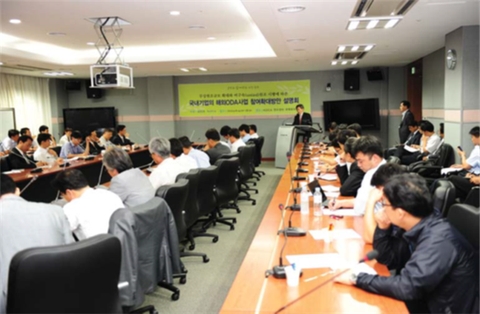
The use of untied ODA started in order to enhance the effectiveness of projects and had a huge impact on the development cooperation procurement environment. ‘ Untied ODA,’ in the context of procurement, is aid that can be given to any corporation, regardless of its nationality, that participates in the bidding process for material and service contracts. Untying aid going into development cooperation has been proposed for a long time within the international society. Efforts to implement untied aid in the development cooperation arena expanded after the DAC High-Level Forum in 1998 and OECD/DAC released the ‘DAC Recommendation on Untying ODA to the Least Developed Countries’in April 2001. Furthermore, the Paris Declaration and the Accra Agenda for Action set untied international development cooperation as major standard for evaluating the effectiveness of development aid. As a result of these efforts, the average percentage of untied development aid by DAC member countries rose to around 85% of their total aid in 2009.
Untied development cooperation does not restrict the country from which goods can be bought and thus can reduce costs as there is a larger market for material and services. KOICA has been expanding untied aid not only as an effort to follow international standards, but also to increase the effectiveness of its development cooperation projects. Principles that are required for untied aid such as transparency, ownership, and domestic procurement are major contributing factors to the effectiveness of international development cooperation.
In 2007, about 24% of Korea’s ODA was untied, well below the international average. Yet this percentage has been gradually increasing since expansion plans for untied aid were finalized at The 5th Committee on International Development Cooperation held on May 1, 2009. To fulfill the Korean government’s plans, KOICA set annual goals for untied aid and reorganized basic systems. According to OECD/DAC statistics, Korea’s ratio of untied aid, which was very low prior to 2007, has been increasing steadily.
[Table 3-2] Average Rate of United Aid for DAC Member Countries and Korea

Source: Korea International Cooperation Agency. 2011. 20 years of KOICA 1991-2010, Translated by Institute for Development and Human Security, Ewha Womans University. Seoul.
4. Improvement of Evaluation System
In the 1990s, the importance of evaluation for the effectiveness of development cooperation projects received a lot of interest both domestically and internationally. In light of this, in 1996 KOICA created a department solely for evaluating its projects. Afterwards, KOICA built a foundation for an evaluation system by analyzing OECD/DAC evaluation principles, guidelines, and the systems of other donor countries. In 1999, KOICA created its project evaluation guidelines and began systematic and regular project evaluation. The guidelines and evaluation procedures have been continuously improved over the years.
The‘ Development Cooperation Evaluation Guideline’was published in 1999 as KOICA’s first attempt at institutionalizing the evaluation process through standards, procedures, and feedback. This was the result of KOICA’s efforts to move beyond the previously limited evaluations which focused on checking for progress and performance. The new evaluation method is more systematic and produces objective results. The ‘Development Cooperation Evaluation Guidelines’states five evaluation standards: appropriateness, effectiveness, efficiency, influence, and sustainability. These evaluation standards are based on OECD/DAC standards and principles, and are still used today. Thus, KOICA has adopted the concept of an evaluation and feedback system based on logical framework and evaluation has become a permanent fixture in KOICA’s project implementation cycle.
In 2006, the project evaluation team was reorganized and expanded into a full department. The concept of evaluation was also expanded to include development policy, strategy, specific sectors, and specific topic. The team suggested a way to link the evaluation results from each project to the achievement of the organization by revising the guidelines for the second time in 2006. This spurred the creation of new contents such as an evaluation model, an evaluation method, and an analytical framework.
[Figure 4-1] KOICA’s Development Cooperation Evaluation Guideline

For the first time in KOICA’s history, KOICA adopted a rating system based on evaluated results. This contributed to standardizing evaluations and making the administrative task of doing evaluation more efficient. In 2008, Korea carried out a complete revision of its evaluation guidelines based international trends and standards in preparation for OECD/DAC membership. In particular, meaningful changes were made by expanding the scope and target of evaluations to include development policy, partner countries’own interests, and international development issues. Moreover, evaluation standards were defined in more detail and cross-cutting issues such as gender equality and environmental preservation were also included. Guidelines for the evaluation procedure and method were expanded in more detail, which had the effect of strengthening the evaluation plan and the quality of the evaluations.
Furthermore, KOICA became the first domestic aid organization to use a feedback system to reflect the results of project evaluation in order to improve future projects. By having partner countries and other donor countries participate in the evaluation, partnerships are being strengthened as well.
[Figure 4-2] KOICA-GTZ Joint Evaluation in the Project Field
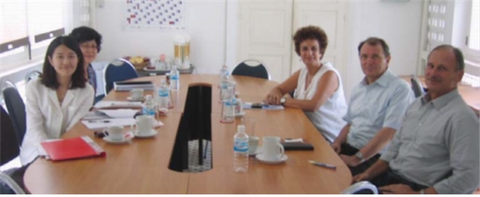
In 2009, KOICA carried out a Joint Evaluation on the Korea-Laos vocational training center construction project with German donor organization GTZ. This was the first co-evaluation project in Korea.
KOICA has been intensifying evaluation functions in all project implementation processes. This will provide a basis for continuous learning. It will also ensure the accountability of international development aid projects by making clear plans to monitor and evaluate their results from the project planning and designing level. In addition, KOICA has been showing leadership by strengthening the evaluation capacity of KOICA staff and outside interested parties, by publishing various evaluation books, and by carrying out evaluation training.
Source: Korea International Cooperation Agency. 2011. 20 years of KOICA 1991-2010, Translated by Institute for Development and Human Security, Ewha Womans University. Seoul.
5. Advancement of ODA Research
KOICA has been focusing intently on policy research with the understanding that policy research is important and necessary for the systematic and adequate establishment, effective implementation, and quality improvement of advanced international development assistance.
The name of KOICA’s research body has changed over time (Research Bureau; Policy Planning and Research Office; Research Office; and Policy Planning, Research and International Organization Office) in response to research needs. KOICA has raced to produce timely and useful policy research on various issues. Topics have been divided by project type, sector, and region. KOICA has also produced research on macro policy and trend analysis in the field of development aid. In initial stages, the Research Bureau consisted of researchers specializing in development issues and regional studies. It provided the basis for untied development cooperation policy while at the same time focusing on mid and long term improvement paths for KOICA. In the 1990s, with Korea’s entrance into OECD in 1996, research was focused on DAC policy direction, regulation, and guidelines, and on the aid policies and strategies of DAC member states. The Research Bureau’s goal in conducting this investigation was to find ways of ways to improve KOICA projects. In addition, it also studied Korea’s development history to determine what the Korean style of development cooperation is.
With the declaration of the UN’s MDGs, the 2000s were an important turning point for the way the international society implemented development cooperation. KOICA increased its project budget, increased ts departments, and bolstered policy research on advanced international development aid. At this time, KOICA attempted to leap forward with its mid/long-term plan to heighten Korea’s international untied development cooperation.
In addition, KOICA published the‘ Development Cooperation Trends’ to introduce major issues and trends in the field of development cooperation. This document contains reference materials on recent ODA policy trends from the OECD/DAC as well as excerpts and translations of writings on international development aid. Furthermore, KOICA has been heightening the awareness of its staff by publishing a glossary of international development cooperation terms and holding monthly conferences in which domestic and foreign figures discuss current topics.
KOICA established the foundation for quantitative research, multilateral cooperation, and research tasks in 2003. By researching ODA trends in developed countries and publishing monthly reports on development cooperation, KOICA was able to strengthen its ability to provide policy research information. KOICA also adopted an outside research contract to improve and diversify internal research. It also made other policy improvements such as reorganizing the standards for research contract performance.
In 2004, KOICA focused on expanding the base for ODA research and enhancing understanding and knowledge of ODA through active projects such as academic research contracts on major ODA topics and by publishing KOICA’s research committee’s research reports. As part of a country-wide research base expansion project on ODA, KOICA held the ‘The 1st Thesis Competition for Undergraduate and Graduate Students in the field of International Development Cooperation’which provided an opportunity for university students to heighten their understanding of ODA projects and participate in cooperative projects. KOICA gave competition winners a chance to experience international cooperation on location.
In 2006, KOICA worked on building a civil society network for ODA made of a pool of experts, NGOs, local government officials, private corporations, and the media by holding the ‘KOICA and Civil Society Partnership Forum.’Through this project, KOICA was able to raise public support for ODA and improve civil society’s participation and understanding of ODA.
KOICA held The 1st Seoul ODA International Conference in 2007 in order to heighten domestic public understanding of international development cooperation, share KOICA’s project results, and increase domestic awareness of major policy issues being discussed within the international community. This conference was held under the title of ‘Effective Ways to Achieve the MDGs’and Professor Jeffery Sachs of Columbia University, a consultant for the UN, was invited to revitalize Korean ODA policy research and increase the understanding and interest of domestic participants on issues related to international development cooperation.
[Figure 5-1] The First Seoul ODA International Conference with the presence of Professor Jeffery Sachs
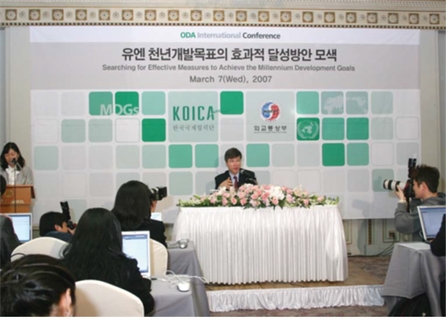
In 2008, KOICA pursued its ODA publicity campaign by publishing ‘Understanding International Development Cooperation,’the first introductory book on international development cooperation from Korea. In addition, research policy was restructured to effectively and systematically manage and improve the quality of both internal and outsourced research. At the 2nd conference, which was held under the theme of ‘Achieving the MDGs: Mid-term Progress Review & Aid Effectiveness,’participants discussed ways of evaluating progress towards achieving the MDGs and how Korea could contribute to this progress through ODA.
[Figure 5-2] The Cover of 'Understanding International Development Cooperation’
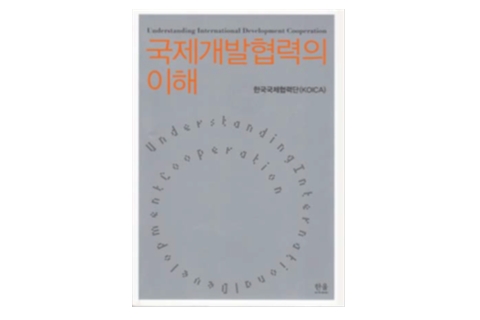
■ This publication is the first introductory book of international cooperation and is widely used in universities.
In 2009, KOICA made efforts to reorganize its policy research system and increase its research capacity and strengthen the connection between the current public policy and the research. To prepare for Korea’s 2010 induction into the DAC, policy research topics were chosen on different issues in order to strengthen the connectivity with priority policies and to increase the synergy between different types of research. This was done according to prior analysis of links between different research tasks. Furthermore, a DAC task force system was created within the Research Office so that DAC related duties could be carried out. At the 3rd conference, entitled‘ The Changing International Development Cooperation Environment and the New Global Partnership for Development Cooperation,’and the 4th conference, entitled ‘Catalyzing Development: A New Vision for Aid,’held in 2009 and 2010 respectively, participants discussed the future path of Korean ODA in the changing international development cooperation environment.
In 2010, the‘ Comprehensive Plan for 2010’was established to build a field oriented policy system, improve effectiveness of development aid by creating a model for sharing Korea’s development experience, and to research DAC issues relating to entering the DAC and hosting the HLF-4 in Busan. KOICA continued work towards expanding its capacity as an ODA policy research institute. KOICA also formed research partnerships with entities such as the Brookings Institute and JICA to improve the quality of its research.
[Figure 5-3] The Cover of‘ Catalyzing Development’
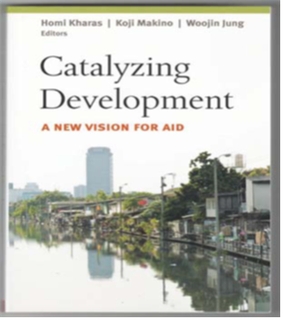
■ Catalyzing Development is a co-work of KOICA, JICA and the Brookings Institute
In addition, KOICA established the ‘KOICA Mid-term Strategy for Research: 2011~2015’and proposed a direction and goals for future ODA policy research. By strengthening research capacity and specializing in development cooperation research, KOICA is enhancing the quality of Korea’s ODA policy and strategy. In other words, KOICA is increasing its reputation as an ODA Think-Tank by building ‘Knowledge-sharing Partnerships’with academics, and fostering a professional workforce in the development cooperation field by establishing the ‘International Development Cooperation Center.’The International Development Cooperation Center’has the combined function of producing valuable research and providing educational opportunities for participants. KOICA is increasing its specialization in research based ODA implementation, evaluation research on policy applicability, communication for research activities, and domestic and foreign partnership for producing development knowledge.
[Figure 5-4] The Final Reports of the Seoul ODA International Conferences

Source: Korea International Cooperation Agency. 2011. 20 years of KOICA 1991-2010, Translated by Institute for Development and Human Security, Ewha Womans University. Seoul.
